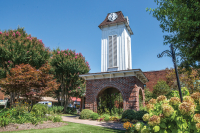Cornell – it’s more than just ivory-billeds
Cornell University and the ivory-billed woodpecker have been inextricably linked since the announcement in 2005 of the rediscovery of the ivory-billed in the Big Woods of Arkansas. Cornell Lab of Ornithology (CLO) has embraced that link. It’s featured prominently on its Web site — the last time I checked, it was the most visited segment — and in their solicitations. There is also a bit of an undercurrent out there of skeptics (including me) who feel that Cornell Lab of Ornithology has not provided an airtight case for its claims. Regardless of where you stand on that issue, there is more to CLO than just ivory-billed woodpeckers.
The CLO was established in 1915 by Arthur Allen, who became America’s first professor of ornithology in 1917. The lab is world-renowned for its work in avian biology, ecology and conservation. The CLO also houses the Library of Natural Sounds, one of the world’s premier collections of bird sound recordings.
The lab focuses on research, education and conservation. Much of the data collected, analyzed and disseminated by Cornell comes from one or more of its many diverse citizen-science projects. These projects include Project FeederWatch, Classroom Feeder Watch, Project PigeonWatch, The House Finch Disease Survey, Birds in Forested Landscapes, The Golden-winged Warbler Atlas, The Cerulean Warbler Atlas, and others including the upcoming Great Backyard Bird Count.
This year will be Cornell’s ninth Great Backyard Bird Count. The count, which will be held from Feb. 17-20, is in collaboration with the National Audubon Society. Last year’s count generated more than 52,000 checklists from across the country. More than 6 million birds representing a record-breaking 613 species were recorded.
Cornell has recently expanded the Great Backyard Bird Count to include parks and public lands. Counters are asked to watch for at least 15 minutes at any given location. Of course, the more time you spend the more comprehensive your data can be. Participants record their data via the Internet.
Related Items
According to Dr. John Fitzpatrick, director of the Cornell Laboratory of Ornithology, “This project has become a major source of scientific information about North American bird populations. It is a classic example of the vital role citizens and the Internet now play in understanding our planet.”
Digital photo records have begun to pour in along with tally sheets on the Internet. Last year, backyard bird counters sent in more than 1,000 digital photos. Many, like the European goldfinch from New Jersey, may be viewed at the GBBC website gallery.
There will be some added incentive this year. According to a CLO press release, “...for the first time, the Lab of Ornithology and Audubon are launching an element of friendly competition. Awards will be given to localities that submit the most checklists, record the greatest number species, or count the highest number of birds. (Last year’s top numbers: 433 checklists from Gautier, Mississippi, 169 species from Corpus Christi, Texas, and 291,246 birds from Squaw Creek National Wildlife Refuge, Missouri.) A photo contest will also be held based on bird pictures taken during the event and submitted for posting on the bird count gallery. Winners will be announced after all the data from the event have been submitted. Everyone can participate, from beginning bird watchers to seasoned experts. Participants enter their numbers online at www.birdsource.org/gbbc and can explore maps, lists, and charts as the count progresses.”
There is no registration for the Great Backyard Bird Count. It is sponsored by Wild Birds Unlimited. For more information, contact the Cornell Lab of Ornithology at This email address is being protected from spambots. You need JavaScript enabled to view it. or 800.843.2473 if in the United States; 607.254.2473 if calling internationally; or contact Audubon at This email address is being protected from spambots. You need JavaScript enabled to view it.; 215.355.9588, Ext. 16, or visit www.birdsource.org.









